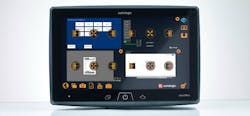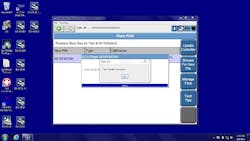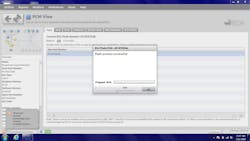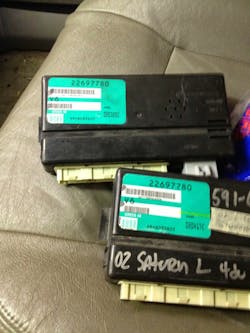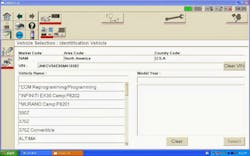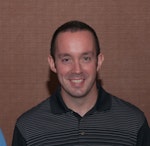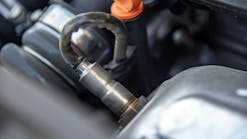We have all been faced with a vehicle that needs a module or component that is part of the onboard vehicle network. We have tested inputs and outputs to come to the expensive conclusion that we need to call the dealer and place the order.
“This is just the beginning of the ‘wild west’ that is module coding and programming,” says John Rogers of JWR Automotive Diagnostics. To make things more interesting, the Massachusetts Right to Repair law is just months away from taking effect, which will ultimately be a game changer for the independent repair industry in regards to dealer level diagnostics becoming available to the independent service sector.
To get a glimpse of what the current world of diagnostics looks like, I sat down with several of New York’s top diagnostic minds who are in the business of offering these factory level services both as mobile repair techs and support personnel. Rogers, Mike Burmester of Advanced Mobile Diagnostics, Justin Kidd of Autologic, Inc., and I work together as part of the automotive advisory board at Suffolk County Community College on Long Island, N.Y., where this very topic came up recently. We later sat down to discuss the ins and outs of coding and programming. This is not another J-2534 how-to, but rather a look at the realities of module replacement and related functions.
Coding, programming, initialization, flashing, calibration and bears — oh my!
The first step in understanding all of these confusing terms is to realize that some are synonymous. The terms largely vary by manufacturer. These terms all refer to the installation and connecting of a module or programmable device to the vehicle network and to inputting the information needed for the module to perform as designed.
Justin Kidd of Autologic had a great analogy for explaining these terms and described them as follows: “Imagine you go to the Apple store and buy an iPhone. The iPhone has the capability to function as a calculator and a camera and can perform a variety of functions because it has an operating system, or program, that allows it to function. However, until the phone is connected to the network and coded with the appropriate account number and phone numbers you will not be able to place a call.”
Thinking of this in this way really simplifies the process. When we purchase a module, it will either arrive with an operating system already installed or it may need to have the program installed with the use of a pass-through device and a factory service information and diagnostic program subscription. In many cases the module will need to be coded and connected to the other modules on the vehicle in very similar fashion to the cell phone description. Again, these processes vary greatly from manufacturer to manufacturer.
His explanation sounds easy right?
It can be, if you are working solely with one manufacturer and specializing on one particular platform, but the reality is that most independent service providers are working on multiple lines.
As with any service procedure be sure to consult the factory level service information and follow the procedures to the letter.
Hardware, operating system and application issues
When venturing into dealer level programming, “computer knowledge is a must,” says Rogers. You are going to have to get familiar with Microsoft Windows operating systems, updates and the various versions of applications such as Internet Explorer, Java and Flash.
Kidd brought up the fact that if you are working with multiple brands to use the “no shared laptops” rule due to the fact that each manufacturers’ requirements for Windows, Internet Explorer as well as programs such as Flash and Java will vary.
“I have 18 laptops for this very reason,” Rogers says. “Turn off Windows automatic updates. Different update levels will give you varying levels of performance and can lead to programming failure.”
“If you are going to perform these functions on multiple brands, it’s a full-time job,” says Burmester. “You need to be an IT guy in order to keep up-to-date. The need for making sure your equipment is ready to roll prolongs the length of the overall process and requires constant updating and in some cases means keeping the laptop you are using out of date so that the software will work properly.”
Some of the software updates can cause manufacturers software to perform poorly or not at all. “In a lot of cases Mercedes wiring diagrams won’t appear if Adobe is updated to the current version,” said Kidd. In a worst case scenario, out of specification software could lock up a programming event and possibly destroy a module.
What does Right to Repair have to do with it?
By now you have probably heard about the Massachusetts Right to Repair law. The law specifies that vehicle manufacturers must provide dealer level diagnostics and functions to the independent service sector by 2017. The Readers Digest version is that independent shops will now have the ability to perform the same level of diagnostic and programming functions through a single pass-through device. No more need for multiple expensive interfaces. Simply purchase the factory subscription and you are ready to go.
While this is a state-specific law, it is widely considered throughout the industry to be a 50 state legislation. While the general automotive public is slowly catching on to right to repair, scan tool manufacturers have seen the writing on the wall for a while now.
“We knew this was coming,” Kidd says of Autologic. “This is an Industry game-changer.” So much so that Autologic, a company known for its high level of diagnostic capabilities on European platforms, went to a new approach with their scan tool platform, the AssistPlus. This leverages the power of live technical support from brand experts, most of whom are master technicians within their brand. An Autologic expert can work in real-time and take control of the scan tool remotely in order to guide technicians through complicated diagnostic and programming functions for various manufacturer applications. This approach seems to speak to the common theme throughout our sit-down in that the biggest problem shops are facing when it comes to providing high tech services such as reprogramming and module replacement is one of information.
The search for good information
“One of the biggest challenges I face on a day-to-day level is the lack of information on the shop owner side of the business. They don’t know where to go to get the info they need. Misinformation is also a big problem,” says Rogers, whose main line of business is as a “hired gun” mobile diagnostician called in when a shop is stuck. While the Right to Repair law has a lot of upside, it will indeed come with its share of issues. Information and technical support seem to be a common theme amongst our diagnostic experts. While the availability of the information and capability to perform advanced functions will be a new line of revenue, shop owners will be challenged with navigating multiple manufacturer service sights without the help and support generally available to the dealers.
Rogers referenced a recent tangle with a Ford 6.0 Powerstroke Diesel and a FICM replacement: “I encountered a failure to program a FICM. I called Rotunda, Ford’s vendor, for assistance, and was told that the failure codes the tool reported were engineering codes that even Rotunda didn’t have access to.” This is typically where a field service engineer or a technical assistance hotline comes in at the dealer level, which, of course, in most cases won’t be available to the independent repair facility.
Burmester has encountered similar problems on Volkswagen and Audi products when installing new factory modules. “I have had error codes before and have been told by technical support that they couldn’t help.” Again, in this case a dealer could most likely get another module from VW/Audi, but how will this work in the aftermarket? It remains to be seen.
Our group did, however, point out a few manufacturers who are easy to work with.
“The GM Tech line is among the most helpful,” said Burmester. In the aftermarket, Drew Technologies, a provider for nearly all of the pass-through and J-2534 devices on the market, provides a high level of technical support. It is at the apex of the reprogramming food chain and is widely considered the “go-to” throughout the industry. “Drew Technologies often has patches for some of the problems we encounter when using a pass through device to program high end European vehicles,” Kidd says.
Building a support network
Locating information coupled with navigating complicated software configurations and an attempt to take on every job that comes through the door will present their share of problems. Our group mentioned the importance of building a network of other shops, mobile diagnostic technicians and support personnel.
“I speak to John three or four times a day,” said Burmester. An amazing factoid being that they are competitors working in the same geographic area. However, the two pointed out the importance of being able to bounce ideas off of each other.
NASTF
The National Automotive Service Task force is a partnership between manufacturers and the Independent service sector that formed as a result of the very issues discussed here so far. According to NASTF.org: “The National Automotive Service Task Force is a not-for-profit organization established to facilitate the identification and correction of gaps in the availability and accessibility of automotive service information, service training, diagnostic tools and equipment, and communications for the benefit of automotive service professionals. NASTF is a cooperative effort among the automotive service industry, the equipment and tool industry and automotive manufacturers.”
NASTF provides the industry with a much needed voice for the independent sector. In addition, it provides resources such as the information needed to purchase manufacturer service information and subscriptions in one common location. They also provide a wealth of information on trending problems with factory tooling, licensing and other emerging issues.
While it is a great wealth of information, like any other resource it cannot be used as a sole source. Their information comes from technicians like you as well as manufacturers who report problems with service information or tooling. Often times they have fixes and sometimes they don’t. Our panel felt that this resource was indeed a good place to start yet has reported that some of the problems they face in real-time have not yet made it to NASTF for dissemination to the automotive public.
The pros and cons of Right to Repair
While discussing coding and programming the topic of Right to Repair goes hand in hand. “The upside to Right to Repair is now anyone can perform the dealer level functions,” comments Kidd. “Subscriptions can often be had inexpensively with per-day, monthly or yearly options.” Some of these options, such as those available through Toyota, can be had at less than $20 for the daily option.
The downside to Right to Repair is also a pause for concern. “No specific automotive affiliation is needed to subscribe and use the factory service information. My sister could download it and attempt to reprogram her own car,” Kidd said jokingly. Of course there is some truth hidden in his sarcasm.
Cost and availability are also reason for concern. While some manufacturers have provided the information and services at low costs, others are priced at an unreachable level while others don’t yet have a solution. “Mercedes does not have a full service solution available today. They have coverage for engine and transmission, but what happens when someone needs to code a headlight?” asked Kidd.
While the right to repair law has been taken seriously by some, others are not yet ready. Time will tell on how they answer the call. There is still some feeling in the business that not all manufacturers will comply. “This law was passed in Massachusetts,” said Rogers. “What will happen in other states if the manufacturers decide not to comply?”
“There are going to be growing pains. Who was lobbying for this? Were they car guys? I have always said be careful what you wish for because you just might get it.”
The margin for error when it comes to performing these dealer level diagnostics is huge. Our panel was all in agreement that it is going to take a lot of the independent garages time. “Shop’s that are committed to dealer level diagnostics will need a tech whose sole job is performing these functions and staying up to date with the technology,” said Burmester. “Dot i’s and cross t’s” when making the decision to perform these functions.”
“I make sure I follow the programming procedures to the letter of the law. I make sure to take each responsible step,” adds Rogers. If and when something fails to go the way it is supposed to while programming, you can take user error out of the equation when following all of the recommended procedures.
Another piece of Right to Repair that had our group concerned was the question of just how much information will be made available. Will we have access to Toyota or other manufacturers technical assistance hotlines? Likely not. “With Chrysler Star cases, which are field engineering reports, are not available to the aftermarket. This is often the information you need to make sure you will be able to perform a critical module replacement” said Rogers. When assistance is available it is often incomplete. “Nissan’s Tech support cannot provide me with proper calibration IDs. We are on our own and we need each other for support.”
The last piece for concern is that once independent service providers take the plunge into dealer level functions they may also be taking on some liability if a vehicle is still within warranty. “There is a bit of a Big Brother aspect here. The OE will know who did what to which car as there will be a record of the work that is done. If a shop does a programming event and the vehicle winds up back at the dealer for a warranty concern, who knows what will happen?” asked Rogers.
As the British say, keep calm and carry on. There are going to be some growing pains, but if you have determination, information and a network of colleagues for support, you may have just discovered a new avenue for business revenue. It’s just not as glitzy as some would have you think. Take it from a few street-wise New Yorkers.
